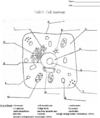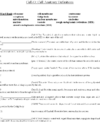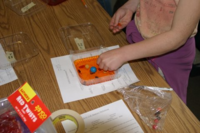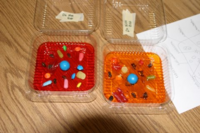Cell-O
| Instant wiki maker | Making handouts | Editing tips |
Biology In Elementary Schools is a Saint Michael's College student project from a course that ran between 2007 and 2010. The student-created resources have been preserved here for posterity. Link under 'toolbox' for printer-friendly versions of the exercises. Click on handouts to print full resolution versions. Please see Wikieducator's disclaimer, our safety statement, and the Creative Commons licensing in English and in legalese.
Student worthiness
Tried and trusted.
Primary biological content area covered
- Cell parts and their functions.
Materials
For One Cell
- 1 box of Jell-o (follow directions) (Cytoplasm)
- 1 knife
- 1 cup of boiling water
- tape for labels
- tooth picks
- 1 cup of cold water
- 1 pen
- 1 cup measuring cup
- 1 Fruit Roll Up (Golgi Body)
- 4 raisins (Vacuole)
- 1 gumdrop (Centrosome)
- 6 M&Ms (Lysosome)
- 4 Mike-and-Ikes (Mitochondrion)
- 1 Gumball(Nucleus)
- 1 Pull 'n' Peel Twizzler (Cut in half for SER and RER, put sprinkles on top of RER)
- 1 plastic container (Cell Membrane)
- 2 pinches of round sprinkles (Ribosomes)
Handouts
Figure 1 is made to fit the shape of our plastic container. It is made to the exact size so students can use it as a map. If this is not the shape of your container you could draw a map of a cell similar to ours that you could use.Description of activity
In this activity students will be able to explore the structure of a cell by building their own models with Jell-o and candy. Students will learn the different parts of the cell and their functions. We will also discuss the importance of cells in the human body.
Lesson plan
1. Learning about the cell.
- First we will pass out a handout introducing the students to an animal cell (see figures 1 and 2 of the handout section), definitions and functions.
2. Reiterating vocabulary of the cell.
- After the students have explored the cell they will begin to create their own.
3. Jell-o.
- Next we will give each student their own container of Jell-o as well as a bag of presorted candy with just enough of each candy for the parts of the cell.
4. Cell construction.
- After every student has received their materials they will begin constructing their cells by placing the candy in the jell-o cytoplasm.
5. Identification.
- When construction is complete student will then make labels for their cells by taking toothpicks and tape to make flags with names on them identifying each cell part.
6. Final Procedures.
- To solidify their knowledge of the cell students will take home a crossword puzzle with definitions of cell parts as clues for the cell part crossword puzzle. We will also discuss how cells are involved in other facets of science as well as the cell's function in the human body.
7. Clean Up.
- Cleaning up is very important and the final step of this activity but in addition as students were not able to eat the candy in this science activity (which must have been very difficult) it would be a nice treat to share any spare candy you have left with the students to celebrate their learning.
Potential pitfalls
- Because the cell is completely edible it is extremely tempting for the students to eat it. Make sure everything is very clean if the cell is to be actually eaten. We chose to not let the students eat the actual cell so we set candy aside for them to eat.
- It is also important not to forget the reason for creating these cells. Students can get distracted by the amount of candy so help them stay focused on learning the parts of a cell.
- Be Organized! This activity would not have ran so smoothly if we did not prepare as much before hand. We made all the Jell-o and counted out all of the candy and put it in bags.
- Set aside plenty of time for this activity. We had about 25 to 30 minutes with each group of kids. With that we still did not have time to make the tooth pick labels. You can make the call on the amount of time you need for each part of this activity.
Art Connections
- Children can have a chance to color the picture on their worksheet to look like the Jell-o cell.
- The construction of the cell itself is an art activity as it is an artistic model.
Literature connections
Teachers can use the books Cells Are Us and Enjoy Your Cells to go along with the lesson. These books are from a new series on cells, protien, and DNA by Frances Balkwill and Mic Rolph. The colorful pictures and simple text is perfect for elementary school age children. Might Animal Cells by Rebecca Johnson can also be used with this activity. The book talks about all different types of animals and their cells.
- Balkwill,Frances R., and Rolph, Mic, 1994, Cells Are Us (Cells and Things), Carolrhoda Books.
- Balkwill,Frances R., and Rolph, Mic,2001, Enjoy Your Cells, Cold Spring Harbor Laboratory Press; 1st edition.
- Johnson, Rebecca L., Fairman, Jennifer E., and Desrocher, Jack, 2007, Mighty Animal Cells, Millbrook Press.
Connections to educational standards
- 7.13 Students understand the characteristics of organisms, see patterns of similarity and differences among living organisms, understand the role of evolution, and recognize the interdependence of all systems that support life. This is evident when students:
- Identify, model, and explain the structure and function (e.g., cells, tissues, organs, systems) of organisms (e.g. plants, animals, microbes), both as individual entities and as components of larger systems
Next steps
- Students can complete this Crossword Puzzle handout (Figure 6) to reiterate the parts of the cell and their functions. Teachers, a great site for making different word games is http://puzzlemaker.discoveryeducation.com/, that is where we got the idea for ours.
- Have students color their worksheet to replicate the cell they made.
- Once students understand what a cell is and how it works try looking at some cells. Use a microscope to show various cells from different parts of animals (ex. Hair, skin, finger nail, etc.).
- Connect this activity to plants and compare the cells of animals to plants.
Citations and links
http://www.enchantedlearning.com/subjects/animals/cell/jello/ Jello Animal Cell
http://puzzlemaker.discoveryeducation.com/ Puzzle Maker
Reflections
- The students really had a lot of fun with this activity. They were not only excited about being able to use candy but they were also excited about cells. They all were interested in the big names and interesting shapes that the cell was made of. When completeing the worksheet all the students were eager to guess which name went with what part. They would look at the picture and make inferences about what the name could be and a lot of times they were right!
- The students seemed very interested in what a cell is and all of it's functions. I feel that they greatly enjoyed making one for themselves and even though the names were hard for them to pronounce they loved guessing what each part was and what its function was. I felt that the worksheets were a great resource because they gave everyone a diagram to work from and the students loved matching up the candy pieces with the the drawing. Although we did not have enough time for the second worksheet the students were very curious and some of them even started working on without help and they were able to get some of the answers right. All in all, I think it went very well and the students were learning and having fun, which is most important.
- The candy we used worked well for the activity. If you can't find everything we have on the list use something else! This activity is great because you can be creative. Use what you think would work best!
- This is a great activity for younger students because they can use something they really love candy and apply it to science, when you take something a child can related to and apply it to your lesson it makes a greater impact. The students really enjoyed learning what each candy stood for and its functions and to avoid problems with the kids eating the candy we had each of them make a sign on the lid of their container and that read "Do not eat!" However, we also gave the students a well deserved treat because working with candy and not eating it is a difficult task.
- We drew the cell on the handout ourselves and I would recommend that if you are not using the same shaped containers to redraw it because we used ours as a map. The students placed their molds on top of the picture and put the candy where it was supposed to go.






